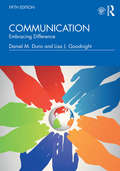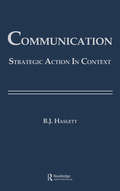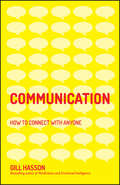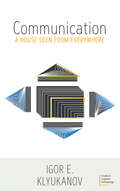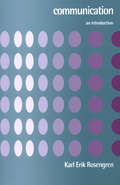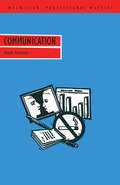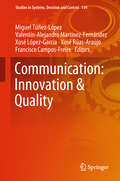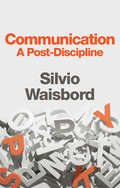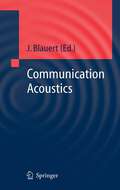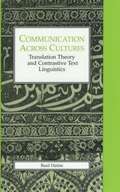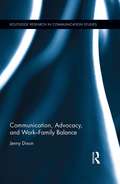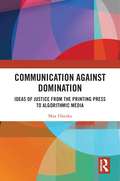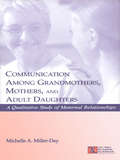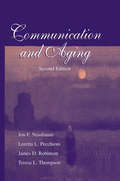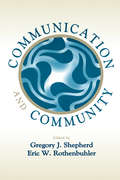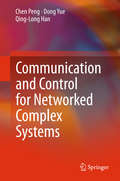- Table View
- List View
Communication: Embracing Difference
by Daniel M Dunn Lisa J GoodnightCommunication: Embracing Difference, 5e, provides the fundamentals of communication theory in accessible terms and emphasizes the practical application of communication skills in interpersonal, small group, and public settings, which helps students become more confident and successful communicators. Designed for the hybrid class, this new edition offers an enhanced dual intercultural and career-based approach; new examples and breakout boxes throughout draw connections to communicating in the workplace, experiential learning, and communicating in a global society. Offering a foundation that readers can take beyond the classroom, this volume is designed to resonate with the diverse student populations that make up so many campuses today.
Communication: Embracing Difference
by Daniel M Dunn Lisa J GoodnightCommunication: Embracing Difference, 5e, provides the fundamentals of communication theory in accessible terms and emphasizes the practical application of communication skills in interpersonal, small group, and public settings, which helps students become more confident and successful communicators. Designed for the hybrid class, this new edition offers an enhanced dual intercultural and career-based approach; new examples and breakout boxes throughout draw connections to communicating in the workplace, experiential learning, and communicating in a global society. Offering a foundation that readers can take beyond the classroom, this volume is designed to resonate with the diverse student populations that make up so many campuses today.
Communication: The Essence of Science (PDF)
by William D. GarveyCommunication: The Essence of Science provides information pertinent to the fundamental aspects of scientific communication. This book focuses on those information-exchange activities that take place mainly among scientists actively involved on the research front. Organized into five chapters, this book begins with an overview of the psychologists' description of the communication structure of science. This text then examines the relationship among spanning, connecting, and integrating the various streams of activities involved in the production of information. Other chapters consider some of the main republication media and suggest ways that may be used in the librarian's effort to provide effective information services to scientists. This book discusses as well the significance of scientific articles to the scientific community. The final chapter deals with the significant role of librarians as a social scientist. This book is a valuable resource for psychologists, social psychologists, librarians, social scientists, sociologists, engineers, teachers, and students.
Communication: Strategic Action in Context (Routledge Communication Series)
by Beth Bonniwell HaslettFirst Published in 1987. Routledge is an imprint of Taylor & Francis, an informa company.
Communication: Strategic Action in Context (Routledge Communication Series)
by Beth Bonniwell HaslettFirst Published in 1987. Routledge is an imprint of Taylor & Francis, an informa company.
Communication: How to Connect with Anyone (Brilliant Business Ser.)
by Gill HassonCommunicate more easily and effectively in any situation! Every day, you have the opportunity to interact with people in different areas of your life; in public, at work and at home, with colleagues and clients, with friends and family. Your ability to exchange ideas and opinions with other people, understand their thoughts and feelings, their point of view and solve problems between you depends on how effectively you’re able to communicate. But being understood, and understanding others is not always easy! Communication is a dynamic, complex process, influenced by all the complexities and differences in human motivation and behaviour. Communication: How to Connect with Anyone will help you connect with others, build friendships and develop better relationships with colleagues and clients, friends and family. This engaging, practical guide shares everything you need to know to develop empathy and rapport with others, and feel confident about communicating with a diverse range of people. This book will help you: Identify, understand and overcome the barriers to communication Explain yourself clearly and be able to manage other people’s responses – whatever they are Know what to say to get others to open up to you Learn how to read between the lines and get a better insight into how others feel, what they do and don’t want Learn how to persuade and influence others Communication: How to Connect with Anyone is a valuable guide for anyone who wishes to communicate effectively, clearly and successfully in all aspects of life.
Communication: How to Connect with Anyone
by Gill HassonCommunicate more easily and effectively in any situation! Every day, you have the opportunity to interact with people in different areas of your life; in public, at work and at home, with colleagues and clients, with friends and family. Your ability to exchange ideas and opinions with other people, understand their thoughts and feelings, their point of view and solve problems between you depends on how effectively you’re able to communicate. But being understood, and understanding others is not always easy! Communication is a dynamic, complex process, influenced by all the complexities and differences in human motivation and behaviour. Communication: How to Connect with Anyone will help you connect with others, build friendships and develop better relationships with colleagues and clients, friends and family. This engaging, practical guide shares everything you need to know to develop empathy and rapport with others, and feel confident about communicating with a diverse range of people. This book will help you: Identify, understand and overcome the barriers to communication Explain yourself clearly and be able to manage other people’s responses – whatever they are Know what to say to get others to open up to you Learn how to read between the lines and get a better insight into how others feel, what they do and don’t want Learn how to persuade and influence others Communication: How to Connect with Anyone is a valuable guide for anyone who wishes to communicate effectively, clearly and successfully in all aspects of life.
Communication: A House Seen from Everywhere (Studies in Linguistic Anthropology #2)
by Igor E. KlyukanovFocusing on the scientific study of communication, this book is a systematic examination. To that end, the natural, social, cultural, and rational scientific perspectives on communication are presented and then brought together in one unifying framework of the semiotic square, showing how all four views are interconnected. The question of whether the study of communication can be considered a unique science is addressed. It is argued that communication is never separate from any object of study and thus we always deal with its manifestations, captured in the four scientific perspectives discussed in the book.
Communication: An Introduction
by Karl Erik RosengrenWritten as an introduction for beginning students, this book offers a thorough, yet lively, overview of human communication in all its aspects. Accessibly written and assuming no prior knowledge of the discipline Communication: An Introduction: offers a thorough, yet lively, examination of all aspects of human communication, including: a summary of its nature, form and function; a detailed analysis of all the levels of communication; a description and overview of the different traditions of communication studies; and a consideration of the future of communication - as a phenomenon and as a field of research.
Communication: An Introduction (PDF)
by Karl Erik RosengrenWritten as an introduction for beginning students, this book offers a thorough, yet lively, overview of human communication in all its aspects. Accessibly written and assuming no prior knowledge of the discipline Communication: An Introduction: offers a thorough, yet lively, examination of all aspects of human communication, including: a summary of its nature, form and function; a detailed analysis of all the levels of communication; a description and overview of the different traditions of communication studies; and a consideration of the future of communication - as a phenomenon and as a field of research.
Communication
by Nicki StantonPreviously published as "The Business of Communicating", this book aims to help anyone interested in improving their communication skills and their knowledge of the way in which communication functions in business. It is a self-contained book, and also a complement to taught courses.
Communication: Innovation & Quality (Studies in Systems, Decision and Control #154)
by Miguel Túñez-López Valentín-Alejandro Martínez-Fernández Xosé López-García Xosé Rúas-Araújo Francisco Campos-FreireThis book explores the disruptive changes in the media ecosystem caused by convergence and digitization, and analyses innovation processes in content production, distribution and commercialisation. It has been edited by Professors Miguel Túñez-López (Universidade de Santiago de Compostela, Spain), Valentín-Alejandro Martínez-Fernández (Universidade da Coruña, Spain), Xosé López-García (Universidade de Santiago de Compostela, Spain), Xosé Rúas-Araújo (Universidade de Vigo, Spain) and Francisco Campos-Freire (Universidade de Santiago de Compostela, Spain). The book includes contributions from European and American experts, who offer their views on the audiovisual sector, journalism and cyberjournalism, corporate and institutional communication, and education. It particularly highlights the role of new technologies, the Internet and social media, including the ethics and legal dimensions. With 30 contributions, grouped into diverse chapters, on information preferences and uses in journalism, as well as public audiovisual policies in the European Union, related to governance, funding, accountability, innovation, quality and public service, it provides a reliable media resource and presents lines of future development.
Communication: A Post-Discipline (Handbooks In Communication And Media Ser. #29)
by Silvio WaisbordCommunication studies is a fragmented field. As a result of its roots in various disciplinary traditions, it is built on fluid intellectual boundaries with no theoretical or analytical center. Should we worry about this state of dispersion or be concerned that the discipline does not meet the basic conditions that define an academic field of inquiry? Silvio Waisbord argues that communication studies is a post-discipline and that it is impossible to transcend fragmentation and specialization through a single project of intellectual unity. What brings communication studies together is an institutional architecture of academic units, professional associations, and journals, rather than a shared commitment to a common body of knowledge, questions, and debates. This should not, Waisbord argues, be a matter of concern. Communication studies is better served by recognizing dispersion, embracing pluralism, fostering cross-cutting lines of inquiry, and tackling real-world problems, rather than hoping to meet conditions which would qualify it as a discipline. Communication: A Post-Discipline is important reading for scholars and advanced students of communication studies, as well as anyone interested in the state of this fascinating and vital academic field.
Communication Acoustics
by Jens BlauertCommunication Acoustics deals with the fundamentals of those areas of acoustics which are related to modern communication technologies. Due to the advent of digital signal processing and recording in acoustics, these areas have enjoyed an enormous upswing during the last 4 decades. The book chapters represent review articles covering the most relevant areas of the field. They are written with the goal of providing students with comprehensive introductions. Further they offer a supply of numerous references to the relevant literature. Besides its usefulness as a textbook, this will make the book a source of valuable information for those who want to improve or refresh their knowledge in the field of communication acoustics – and to work their way deeper into it. Due to its interdisciplinary character Communication Acoustics is bound to attract readers from many different areas, such as: acoustics, cognitive science, speech science, and communication technology.
Communication Across Cultures: Translation Theory And Contrastive Text Linguistics (Exeter Language And Lexicography Ser. (PDF))
by Basil HatimWhile the literature on either contrastive linguistics or discourse analysis has grown immensely in the last twenty years, very little of it has ventured into fusing the two perspectives. Bearing in mind that doing discourse analysis without a contrastive base is as incomplete as doing contrastive analysis without a discourse base, the specific aim of this book is to argue that translation can add depth and breadth to both contrastive linguistics as well as to discourse analysis. Authentic data from both spoken and written English is used throughout to add clarity to theoretical insights gained from the study of discourse processing. Each aspect of the model proposed for the analysis of texts is related separately to a problem of language processing and in domains as varied as translation, interpreting, language teaching etc. The global objectives pursued in this volume are the training of future linguists and the sensitization of users of language in general to the realities of discourse.
Communication, Advocacy, and Work/Family Balance (Routledge Research in Communication Studies)
by Jenny DixonThis book presents an understanding of work-family balance for working adults belonging to a number of different family structures (e.g. single and/or childfree adults, LGBT couples, families with female breadwinners). It contends that family structure should serve as a way of thinking about diversity (i.e., race, gender, age, family) in the U.S. workplace. It also argues that—in addition to accommodations occurring through workplace policy—the negotiation of work-family balance happens as a result of self-advocacy that occurs in everyday communication about family at work. Relaying the stories of a number of different working adults belonging to a variety of different family structures, it explores the range of obstacles faced in the attempt at balancing work and family life, generates informed ideas for eliminating barriers commonly experienced in balancing work and family, and problematizes enduring assumptions regarding gender roles and the myth of steadfast public and private spheres.
Communication, Advocacy, and Work/Family Balance (Routledge Research in Communication Studies)
by Jenny DixonThis book presents an understanding of work-family balance for working adults belonging to a number of different family structures (e.g. single and/or childfree adults, LGBT couples, families with female breadwinners). It contends that family structure should serve as a way of thinking about diversity (i.e., race, gender, age, family) in the U.S. workplace. It also argues that—in addition to accommodations occurring through workplace policy—the negotiation of work-family balance happens as a result of self-advocacy that occurs in everyday communication about family at work. Relaying the stories of a number of different working adults belonging to a variety of different family structures, it explores the range of obstacles faced in the attempt at balancing work and family life, generates informed ideas for eliminating barriers commonly experienced in balancing work and family, and problematizes enduring assumptions regarding gender roles and the myth of steadfast public and private spheres.
Communication Against Domination: Ideas of Justice from the Printing Press to Algorithmic Media
by Max HänskaThis book tackles the philosophical challenge of bridging the gap between empirical research into communication and information technology, and normative questions of justice and how we ought to communicate with each other. It brings the question of what justice demands of communication to the center of social science research. Max Hänska undertakes expansive philosophical analysis to locate the proper place of normativity in social science research, a looming subject in light of the sweeping roles of information technologies in our social world today. The book’s first section examines metatheoretical issues to provide a framework for normative analysis, while the second applies this framework to three technological epochs: broadcast communication, the Internet and networked communications, and the increasing integration of artificial intelligence and machine learning technologies into our communication systems. Hänska goes beyond the prevailing frameworks in the field by exploring how we answer normative questions and how our answer can change depending on our social context and the affordances of prevailing communications technologies. This book provides an essential guide for scholars as well as graduate and advanced undergraduate students of research and theory in communication, philosophy, political science, and the social sciences.
Communication Against Domination: Ideas of Justice from the Printing Press to Algorithmic Media
by Max HänskaThis book tackles the philosophical challenge of bridging the gap between empirical research into communication and information technology, and normative questions of justice and how we ought to communicate with each other. It brings the question of what justice demands of communication to the center of social science research. Max Hänska undertakes expansive philosophical analysis to locate the proper place of normativity in social science research, a looming subject in light of the sweeping roles of information technologies in our social world today. The book’s first section examines metatheoretical issues to provide a framework for normative analysis, while the second applies this framework to three technological epochs: broadcast communication, the Internet and networked communications, and the increasing integration of artificial intelligence and machine learning technologies into our communication systems. Hänska goes beyond the prevailing frameworks in the field by exploring how we answer normative questions and how our answer can change depending on our social context and the affordances of prevailing communications technologies. This book provides an essential guide for scholars as well as graduate and advanced undergraduate students of research and theory in communication, philosophy, political science, and the social sciences.
Communication Among Grandmothers, Mothers, and Adult Daughters: A Qualitative Study of Maternal Relationships (LEA's Series on Personal Relationships)
by Michelle A. Miller-DayThis volume examines communication processes within the grandmother-mother-daughter relationship, emphasizing an intergenerational perspective. Using observations of and extensive interviews with six sets of middle-income, Caucasian female family members, this book offers a heuristic account of intergenerational mother-daughter relational communication.Author Michelle Miller-Day integrates and juxtaposes alternative experiences of social interaction, situating readers in the world of grandmothers, mothers, adult daughters, and granddaughters as they experience, describe, and analyze their family communication. Miller-Day incorporates aged mothers and younger mid-life mothers and their adult daughters into the research to illustrate how this type of maternal relationship is experienced at different points in a woman's life. With the inclusion of three generations of women, Miller-Day offers multigenerational perspectives on family, and examines them for patterns of maternal interaction, providing symbolic links across generational boundaries.Communication Among Grandmothers, Mothers, and Adult Daughters enables readers to understand more completely the richly textured nature of maternal relationships. It will be an invaluable resource for scholars and researchers in the areas of communication and relationships, including family communication, intergenerational communication, women's studies, family studies, interpersonal communication, and relationships, as well as social workers, psychologists, and counselors, who strive to understand family communication processes and their dynamics across generational lines.
Communication and Aging (Routledge Communication Series)
by Jon F. Nussbaum Loretta L. Pecchioni James D. Robinson Teresa L. ThompsonThis text employs a communication perspective to examine the aging process and the ability of individuals to adapt successfully to aging. It continues the groundbreaking work of the first edition, emphasizing a life-span approach toward understanding the social interaction that occurs during later life. The edition provides a comprehensive update on the existing and emerging research within communication and aging studies and considers such topics as notions of successful aging, positive and negative stereotypes toward older adults, and health communication issues. It raises awareness of the barriers facing elderly people in conversation and the importance such conversations have in elderly people's lives. The impact of nonrelational processes, such as hearing loss, are considered as they impact relationships with others and affect the ability to age successfully. The book is organized into 14 chapters. Each chapter is written so that the reader is presented with an exhaustive review of the pertinent and recent literature from the social sciences. As in the first edition, when the literature is empirically based, the communicative ramifications are then discussed. Readers of this volume will gain greater understanding of the importance of their communicative relationships and how significant they remain across the life span. Developed for students in communication, psychology, nursing, social gerontology, sociology, and related areas, Communication and Aging provides important insights on communication to all who are affected by the aging process.
Communication and Aging (Routledge Communication Series)
by Jon F. Nussbaum Loretta L. Pecchioni James D. Robinson Teresa L. ThompsonThis text employs a communication perspective to examine the aging process and the ability of individuals to adapt successfully to aging. It continues the groundbreaking work of the first edition, emphasizing a life-span approach toward understanding the social interaction that occurs during later life. The edition provides a comprehensive update on the existing and emerging research within communication and aging studies and considers such topics as notions of successful aging, positive and negative stereotypes toward older adults, and health communication issues. It raises awareness of the barriers facing elderly people in conversation and the importance such conversations have in elderly people's lives. The impact of nonrelational processes, such as hearing loss, are considered as they impact relationships with others and affect the ability to age successfully. The book is organized into 14 chapters. Each chapter is written so that the reader is presented with an exhaustive review of the pertinent and recent literature from the social sciences. As in the first edition, when the literature is empirically based, the communicative ramifications are then discussed. Readers of this volume will gain greater understanding of the importance of their communicative relationships and how significant they remain across the life span. Developed for students in communication, psychology, nursing, social gerontology, sociology, and related areas, Communication and Aging provides important insights on communication to all who are affected by the aging process.
Communication and Community (Routledge Communication Series)
by Gregory J. Shepherd Eric W. RothenbuhlerThis distinctive volume combines synthetic theoretical essays and reports of original research to address the interrelations of communication and community in a wide variety of settings. Chapters address interpersonal conversation and communal relationships; journalism organizations and political reporting; media use and community participation; communication styles and alternative organizations; and computer networks and community building; among other topics. The contents offer synthetic literature reviews, philosophical essays, reports of original research, theory development, and criticism. While varying in theoretical perspective and research focus, each of the chapters also provides its own approach to the practice of communication and community. In this way, the book provides a recurrent thematic emphasis on the pragmatic consequences of theory and research for the activities of communication and living together in communities. Taken as a whole, this collection illustrates that communication and community cannot be adequately analyzed in any context without considering other contexts, other levels of analysis, and other media and modes of communication. As such, it provides important insights for scholars, students, educators, and researchers concerned with communication across the full range of contexts, media, and modes.
Communication and Community (Routledge Communication Series)
by Gregory J. Shepherd Eric W. RothenbuhlerThis distinctive volume combines synthetic theoretical essays and reports of original research to address the interrelations of communication and community in a wide variety of settings. Chapters address interpersonal conversation and communal relationships; journalism organizations and political reporting; media use and community participation; communication styles and alternative organizations; and computer networks and community building; among other topics. The contents offer synthetic literature reviews, philosophical essays, reports of original research, theory development, and criticism. While varying in theoretical perspective and research focus, each of the chapters also provides its own approach to the practice of communication and community. In this way, the book provides a recurrent thematic emphasis on the pragmatic consequences of theory and research for the activities of communication and living together in communities. Taken as a whole, this collection illustrates that communication and community cannot be adequately analyzed in any context without considering other contexts, other levels of analysis, and other media and modes of communication. As such, it provides important insights for scholars, students, educators, and researchers concerned with communication across the full range of contexts, media, and modes.
Communication and Control for Networked Complex Systems
by Chen Peng Dong Yue Qing-Long HanThis book reports on the latest advances in the study of Networked Control Systems (NCSs). It highlights novel research concepts on NCSs; the analysis and synthesis of NCSs with special attention to their networked character; self- and event-triggered communication schemes for conserving limited network resources; and communication and control co-design for improving the efficiency of NCSs. The book will be of interest to university researchers, control and network engineers, and graduate students in the control engineering, communication and network sciences interested in learning the core principles, methods, algorithms and applications of NCSs.
